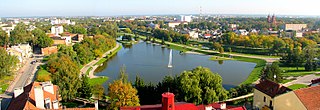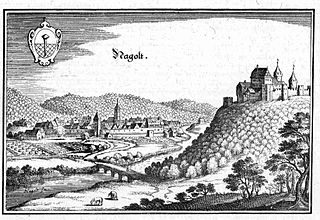
Woodlawn is an unincorporated community and census-designated place in Baltimore County, Maryland, United States. The population was 37,879 at the 2010 census. It is home to the headquarters of the Social Security Administration (SSA) and the Centers for Medicare and Medicaid Services (CMS). It is bordered by Catonsville on the south, by the Patapsco River and Howard County on the west, by Randallstown and Lochearn to the north, and by the City of Baltimore to the east. Parts of Woodlawn are sometimes informally referred to as Security, Maryland, due to the importance of the SSA's headquarters as well as nearby Security Boulevard and Security Square Mall.

Freiburg is one of the four Regierungsbezirke of Baden-Württemberg, Germany, located in the south-west of the country. It covers the Black Forest (Schwarzwald) hills as well as the Rhine valley. It is sub-divided into the three regions (Regionalverband) Hochrhein-Bodensee, Schwarzwald-Baar-Heuberg and Südlicher Oberrhein.

Jean-Frédéric Maximilien de Waldeck was a French antiquarian, cartographer, artist and explorer. He was a man of talent and accomplishment, but his love of self-promotion and refusal to let the truth get in the way of a good story leave some aspects of his life in mystery.

The County of Waldeck was a state of the Holy Roman Empire and its successors from the late 12th century until 1929. In 1349 the county gained Imperial immediacy and in 1712 was raised to the rank of Principality. After the dissolution of the Holy Roman Empire in 1806 it was a constituent state of its successors: the Confederation of the Rhine, the German Confederation, the North German Confederation, the German Empire and, until 1929, the Weimar Republic. It comprised territories in present-day Hesse and Lower Saxony (Germany).
Waldeck-Frankenberg is a Kreis (district) in the north of Hesse, Germany. Neighbouring districts are Höxter, Kassel, Schwalm-Eder, Marburg-Biedenkopf, Siegen-Wittgenstein, Hochsauerland.

Panevėžys County is one of ten counties in Lithuania. It is in the north-east of the country, and its capital is Panevėžys. On 1 July 2010, the county administration was abolished, and since that date, Panevėžys County remains as the territorial and statistical unit.

Liechtenstein Castle is a privately owned castle near Maria Enzersdorf in Lower Austria, bordering Vienna. It is on the edge of the Wienerwald. The castle, originally built during the 12th century, was destroyed by the Ottomans in 1529 and 1683, and it remained in ruins until 1884, when it was rebuilt.
Hitchie Creek Provincial Park is a provincial park in British Columbia, Canada, west of the north end of Nitinat Lake in the West Coast of Vancouver Island region, northeast of Bamfield.

All Saints' Abbey was a Premonstratensian monastery near Oppenau in the Black Forest in Baden-Württemberg, Germany.

The Prince-Bishopric of Osnabrück) was an ecclesiastical principality of the Holy Roman Empire from 1225 until 1803. It should not be confused with the Diocese of Osnabrück, which was larger and over which the prince-bishop exercised only the spiritual authority of an ordinary bishop. It was named after its capital, Osnabrück.

Torpaqkörpü is a village in the Qusar Rayon of Azerbaijan.

Rokitki is a village in the administrative district of Gmina Tczew, within Tczew County, Pomeranian Voivodeship, in northern Poland. It lies approximately 3 kilometres (2 mi) south-east of Tczew and 33 km (21 mi) south of the regional capital Gdańsk. The village was previously known as Reisicht.

Kiekskiejmy is a village in the administrative district of Gmina Dubeninki, within Gołdap County, Warmian-Masurian Voivodeship, in northern Poland, close to the border with the Kaliningrad Oblast of Russia. It lies approximately 13 kilometres (8 mi) north-east of Dubeninki, 28 km (17 mi) east of Gołdap, and 159 km (99 mi) north-east of the regional capital Olsztyn.

Golec is a settlement in the administrative district of Gmina Orzysz, within Pisz County, Warmian-Masurian Voivodeship, in northern Poland. It lies approximately 16 kilometres (10 mi) north-west of Orzysz, 30 km (19 mi) north of Pisz, and 82 km (51 mi) east of the regional capital Olsztyn.

The West Hesse Highlands, also known as the West Hessian Lowlands and Highlands, refers to a heavily forested region of the Central Uplands in Germany that lies mostly within the state of Hesse, between those elements of the Rhenish Massif right of the Rhine in the west, the Weser Uplands to the north, the Hessian Central Uplands to the east and the Wetterau to the south.

Hohennagold Castle is a ruined castle situated on a hill, the so-called Schlossberg, overlooking the Black Forest town of Nagold. The hill consists predominantly of porphyritic rock. The ruins represent a relatively well-preserved 12th-century castle. The keep behind the curtain walls, a tower in the north-western corner of the complex as well as the outer ward with half-round and angular towers, are still visible. Around the castle there appears to have been a moat.

The Merkur or Großer Staufenberg is a mountain, 668.3 m above sea level (NHN), in the Northern Black Forest, Baden-Württemberg, Germany. It is the Hausberg of Baden-Baden and located between the spa town and the town of Gernsbach.

The ruins of Waldeck Castle are in the Upper Palatinate region of the state of Bavaria in Germany, on a hill overlooking the village of Waldeck, near Kemnath.

Bottendorf is a district in the Gemeinde of Burgwald, located in Waldeck-Frankenberg, Hesse, Germany. According to the 2011 census, the population is roughly 1,950 individuals. With an area of 1.53 km², the population density of Bottendorf is 1,274/km².

The Wiesental, named after the river Wiese, is a valley in the Southern Black Forest. The Wiese is a right-hand tributary of the Rhine which has its source in Feldberg and flows into the Rhine in Basel, Switzerland. The Wiesental was one of the first industrialized regions of the former grand dutchy of Baden and an important production location for the textile industry.

















